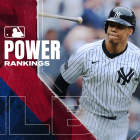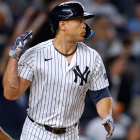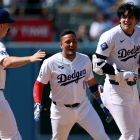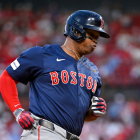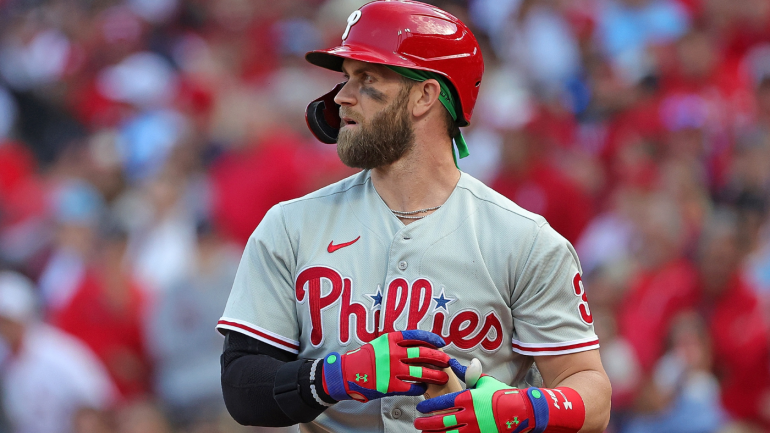
The first weekend of the 2022 MLB postseason is in the books. The new best-of-three Wild Card Series brought us only one Game 3, but it was eventful, and we also got to see a stunning seven-run comeback and a 15-inning game end with a walk-off homer. All things considered, it was an excellent weekend of postseason baseball.
The four victors of the Wild Card Series advanced to the Division Series and will face the four teams that earned a first-round bye -- the division winners with the two best records in each league. Here are the Division Series matchups:
American League
National League
Travel returns in the Division Series. Every Wild Card Series game was played at the higher seed's ballpark. The usual 2-2-1 format returns for the Division Series, with Game 1 and 2, as well as a potential Game 5, played at the higher season's stadium. That means postseason baseball is guaranteed to be played in Seattle for the first time since 2001. Neat.
Here is the full postseason schedule. All four Division Series matchups begin Tuesday, so it's another full day of postseason action. Now here are two X-factors -- one obvious and one less obvious -- for the four Division Series matchups. Let's dive in.
Atlanta Braves vs. Philadelphia Phillies
Obvious X-factor: Harper's thumb. An errant fastball broke Bryce Harper's left thumb on June 25 and the break was severe enough to require surgery. Harper returned on Aug. 26 but wasn't himself, slashing .227/.325/.352 with only three home runs in 35 games the rest of the season. He went 2 for 7 with a home run in the Wild Card Series -- the home run was his first pulled to right field since the thumb injury -- and it's hard to see how the Phillies can beat the defending World Series champs without Harper being a major contributor. Hitting the ball over the fence isn't the only way to help your team, but it sure does help.
Less obvious X-factor: The Braves and the bottom of the zone. There's no surprise here, but the 101-win Braves were one of the best offensive teams in baseball this year. As a unit their offense ranked eighth in batting average (.253), ninth in on-base percentage (.317), first in slugging percentage (.443), and second in home runs (243). Maybe the batting average and on-base percentage aren't truly elite, but the power sure is. Atlanta can slug with anyone.
Braves' hitters are especially gifted at doing damage on pitches in the lower third of the strike zone. It is difficult to elevate those pitches and do more than hit a ground ball with eyes. Here are the MLB averages in various parts of the strike zone:
| AVG | SLG | |
|---|---|---|
Upper third | .243 | .418 |
Middle third | .301 | .523 |
Lower third | .268 | .429 |
Belt high is the happy zone. Up in the zone is tough -- that's usually where hitters see the most velocity -- and so is the bottom of the zone. Not for the Braves though. Their hitters led baseball in batting average (.310) and slugging percentage (.528) on pitches in the lower third of the zone, and by a lot too. The Dodgers are second at .289 and .477, respectively.
Pitch down in the zone and the Braves will make you pay. And, sure enough, the Phillies pitched down in the zone more than any postseason team this year. Their pitchers threw 17.8 percent of their pitches in the lower third of the zone during the regular season, or close to one out of every five. Several individual Phillies pitch at the bottom of the zone even more frequently:
- Zach Eflin: 21.9 percent (fifth highest rate in baseball)
- David Robertson: 20.8 percent
- Ranger Suárez: 20.1 percent
- Aaron Nola: 17.9 percent
That's two starters and two high-leverage relievers (Eflin has been closing games since returning from a knee injury in September) who regularly attack the lower third of the zone, a place where Braves' hitters thrive. What do you do if you're the Phillies? Ask your pitchers to change and not do what got them to the NLDS? That's setting your players up for failure. I'm not sure what the adjustment is, but Philadelphia's pitchers have had success pitching one way and it just so happens Atlanta's hitters fare well against that pitching style.
Cleveland Guardians vs. New York Yankees
Obvious X-factor: Yankees' hitters other than Judge. I don't know how the Guardians plan to attack Aaron Judge, but he is closest thing we've seen to peak Barry Bonds since Bonds. I say that in the sense that Judge does not get much to hit these days, yet anything he does get to hit is a laser. He isn't missing anything. Should Cleveland pitch around Judge, then it'll be up to Anthony Rizzo, Giancarlo Stanton, Gleyber Torres, and others to make them pay.
Less obvious X-factor: Cleveland's running game. No postseason team stole more bases (119) or attempted more stolen bases (146) during the regular season than the Guardians, and only the Dodgers had a higher stolen base success rate (84 percent to 82 percent). Only the punchless Tigers hit fewer home runs than Cleveland during the regular season. The Guardians rely on stolen bases to help generate offense because they rarely produce that one big swing to put runs on the board.
The Yankees, meanwhile, were one of baseball's most effective teams at shutting down the running game. They were one of the worst teams at preventing steals in 2021, but thanks to an effort spearheaded by third base coach Luis Rojas, the Yankees now keep the opposition in check on the bases as well as any team in the game. A few numbers:
| 2021 | 2022 | |
|---|---|---|
SB allowed | 86 (9th most in MLB) | 49 (fewest in MLB) |
SB attempts against | 103 (8th most) | 77 (3rd fewest) |
Caught stealing rate | 17% (2nd worst) | 36% (2nd best) |
It will be strength vs. strength in the ALDS. It's an aggressive stolen base team against arguably the best team at limiting stolen bases. If Cleveland can break through and steal some bases, they'll be in good shape offensively. If the Yankees shut the running game down, the Guardians could have real trouble putting runs on the board given their lack of power.
Houston Astros vs. Seattle Mariners
Obvious X-factor: Seattle's Minute Maid Park demons. As the lower seed, the Mariners must win a game in Houston to win the ALDS. And, over the last three seasons, the Mariners are 7-20 -- 7-20! -- at Minute Maid park while being outscored 157-78. That's an average of 2.93 runs per game. The Mariners went 3-7 in Houston this year (outscored 47-26), though I guess the good news is they were 3-4 in their last seven? That's something. For AL teams, the road to the World Series goes through Houston. The Mariners have to find a way to break through and win (at least) one game at Minute Maid to advance.
Less obvious X-factor: Keeping the Astros grounded. Only four offenses had a lower ground ball rate than the Astros this season. Their 40.7 percent ground ball rate was comfortably below the 42.9 percent league average, and a few of their individual hitters ran ground ball rates under 40 percent: Yordan Alvarez (39.1 percent), Alex Bregman (33.3 percent), and Kyle Tucker (34.1 percent). Hit the ball in the air and good things happen -- ground balls don't go for extra-base hits all that often -- and the Astros hit the ball in the air more than only a handful teams.
The Astros hit plenty of fly balls and the Mariners' pitching staff allows an awful lot of fly balls. Their team 39.8 percent ground ball rate allowed was the lowest in baseball. You have an offense that hits a lot of fly balls and a pitching staff that allows a lot of fly balls. Perhaps it is no surprise then that Seattle's pitching staff had a 1.2 HR/9 rate against the Astros this year, their fourth-worst rate allowed against an individual team (min. seven games played).
That said, pitching staffs change in October. Teams lean on their best pitchers in the postseason and several of Seattle's best ground ball arms weren't with the club all season, but will be in the ALDS. Those pitchers and their ground ball rates:
- Andrés Muñoz (52.6 percent): A reliever who will be used in the game's biggest moments.
- Matt Brash (51.6 percent): Started 2022 as a starter, went to Triple-A, returned as a reliever in July.
- Luis Castillo (46.9 percent): Acquired at the trade deadline.
- Diego Castillo (46.2 percent): Another reliever who will pitch primarily in high-leverage situations.
- George Kirby (45.5 percent): It's a 47.7 percent ground ball rate since returning from Triple-A in July.
As a whole, Seattle's pitching staff did not get many ground balls this season. Their ALDS roster will feature several pitchers who are quite good at getting ground balls, however, including three relievers (Brash, Castillo, Muñoz) whose usage will be leveraged in important situations. When push comes to shove, the Mariners will have someone on the mound who can get a ground ball, and against an offense that elevates as much as the Astros, that's a necessity.
Los Angeles Dodgers vs. San Diego Padres
Obvious X-factor: The Dodgers' closer. It seems unlikely Craig Kimbrel will be entrusted with a small ninth-inning lead. He struggled most of the season and the Dodgers removed him from the closer's role in September. The team with baseball's best record doesn't do that often. Los Angeles intends to mix and match in the ninth inning and they have good options (Evan Phillips, Alex Vesia, etc.), though the more buttons you have to push, the more likely you are to push the wrong one. Ninth-inning issues can lead to a quick postseason exit.
Less obvious X-factor: The Dodgers against premium velocity. Velocity reigns supreme in October. The average -- average -- fastball was 94.5 mph during the Wild Card Series and 26.1 percent of all fastballs were at least 97 mph. Those numbers were 93.1 mph and 10.4 percent during the regular season, respectively. Velocity is not everything but it is definitely a thing. The faster the pitch, the less time the hitter has to react. It really is that simple.
In terms of hitting velocity, only the Braves compare to the Dodgers. Los Angeles' hitters posted a .263 batting average and a .463 slugging percentage against 95 mph or better fastballs during the regular season. The Braves were at .264 and .473, respectively, and the MLB averages are .240 and .374, again respectively. Bump it up to 97 mph or better and Dodgers batters hit .273. No other team was over .262. When it comes to top-of-the-line velocity, almost no team compares to the Dodgers.
Only a few teams can bring the heat like the Padres and, thanks to San Diego's win over the Mets on Sunday, they now head to Los Angeles for the NLDS. Padres pitchers threw 18.3 percent of their pitches at 95 mph or better and 6.6 percent at 97 mph or better this year. Only the Yankees had higher rates among postseason teams. San Diego's bullpen is built around velocity. Look at that average velocity of their core late innings relievers:
| Average fastball | Pitches at 95+ mph | Pitches at 97+ mph | |
|---|---|---|---|
97.4 mph | 54.8% | 50.3% | |
97.4 mph | 76.0% | 66.1% | |
96.9 mph | 66.1% | 32.0% | |
97.9 mph | 65.4% | 44.4% |
Blake Snell deserves a mention here because he's one of the hardest-throwing starters in baseball -- his heater averaged 95.7 mph this year and 45.1 percent of his pitches were 95 mph or better -- but goodness, San Diego is going to shove velocity down the other team's throat in the late innings. García, Hader, and Suarez are manager Bob Melvin's most trusted late-inning relievers and they all throw extremely hard. They throw extremely hard and extremely hard very often.
The Dodgers pantsed the Padres during the regular season, going 14-5 against them and outscoring them 109-47, and one reason was San Diego's bullpen posting a 5.38 ERA during the season series. The Padres built their bullpen around top-of-the-line velocity and hey, that's great. You want batters to struggle to make contact in the late innings. That said, the Dodgers have built an offense that excels at hitting premium velocity. That will undoubtedly be a factor in the NLDS this coming week.














